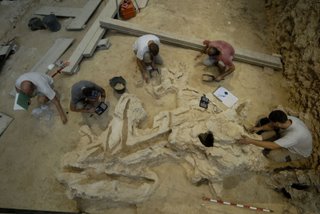
56,000 years ago the Neanderthals that occupied the Abric Romaní, at Capellades (Barcelona), made use of the forest mass that grew in the edge of the shelter. Remains of trees cut by these hominids have been fossilized in the level P, being the one of larger diameter of 40 centimeters; whereas the base of the trunk, of a meter of height, remains in vertical position, the branches are scattered surrounding. The Neanderthals used wood to make fire and also to make tools for the hunt, the gathering and the domestic use. These archaeological remains are the most ancient ever found at this shelter, where they have been found fossilized plants from the 40,000 to 70,000 years.
This discovery confirms the importance that had fire and plants for the Neanderthals to their domestic activities, associated to workshops of manipulation of the wood. The Abric Romaní is the most important archaeological site in the world with wood tools and hearths excavated in the last 25 years. Until the moment it has been investigated more than 300 hearths and has been located more than 100 of wood tools from 40,000 to 56,000 years.
The plant preservation at this site is caused by the abundance of calcic bicarbonate in the water at Capellades. The water that flows from the sources covers the plant surfaces that fossilize the external part of them. In this way, when the woody material disappears, its imprint remains. Constructing a mold over this negative we could obtain a positive of it that allows us to know the original form of its structure.
The excellent preservation of fossils at this site (wood, stone and bone) makes easier the approximate reconstruction of the last Neanderthals’ life before their extinction. Specifically, this discovery allows us to confirm the complexity of the Neanderthal behaviour, which has been often put in doubt by some scientists.
No comments:
Post a Comment